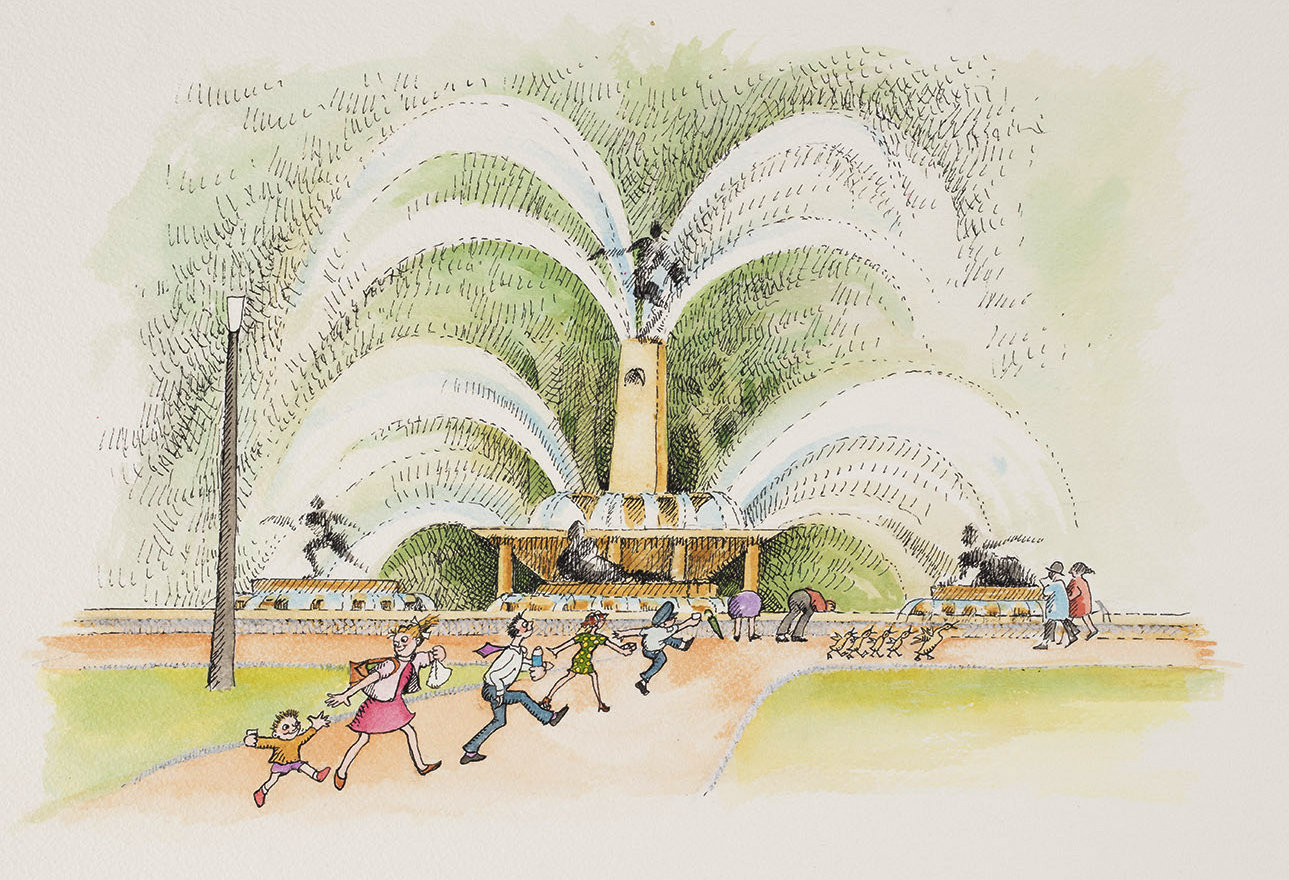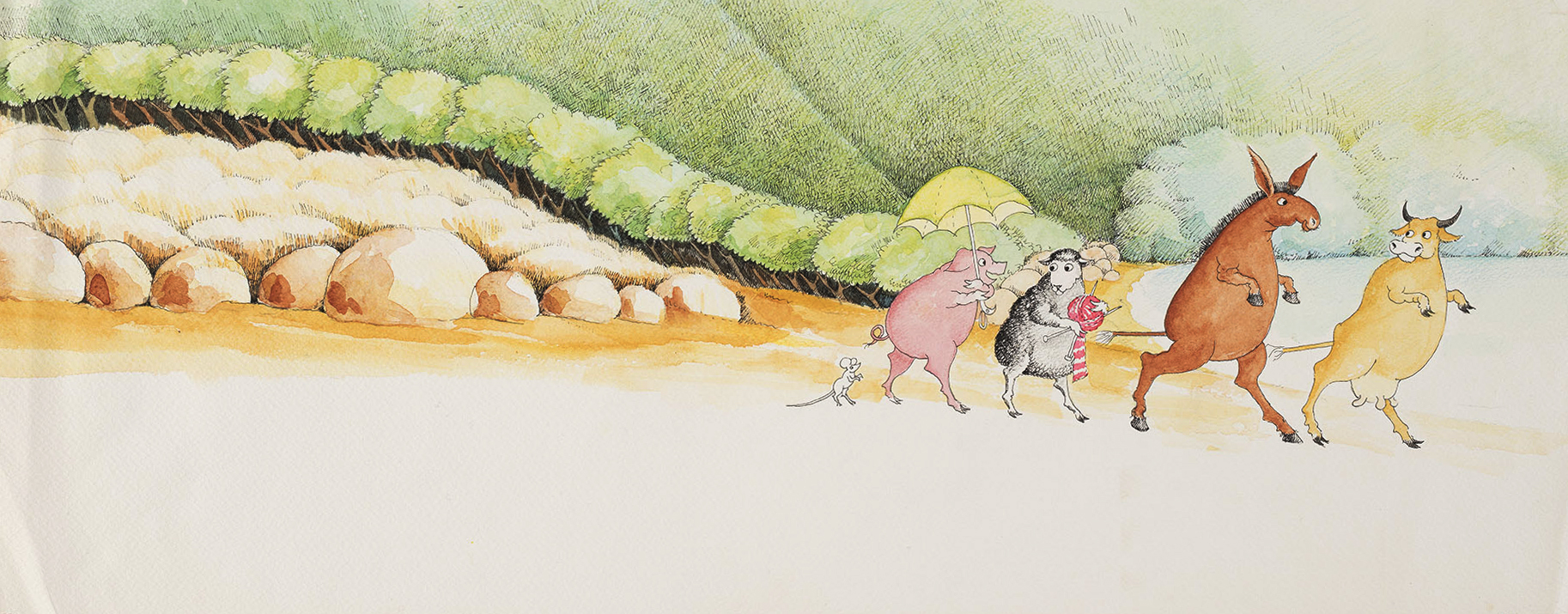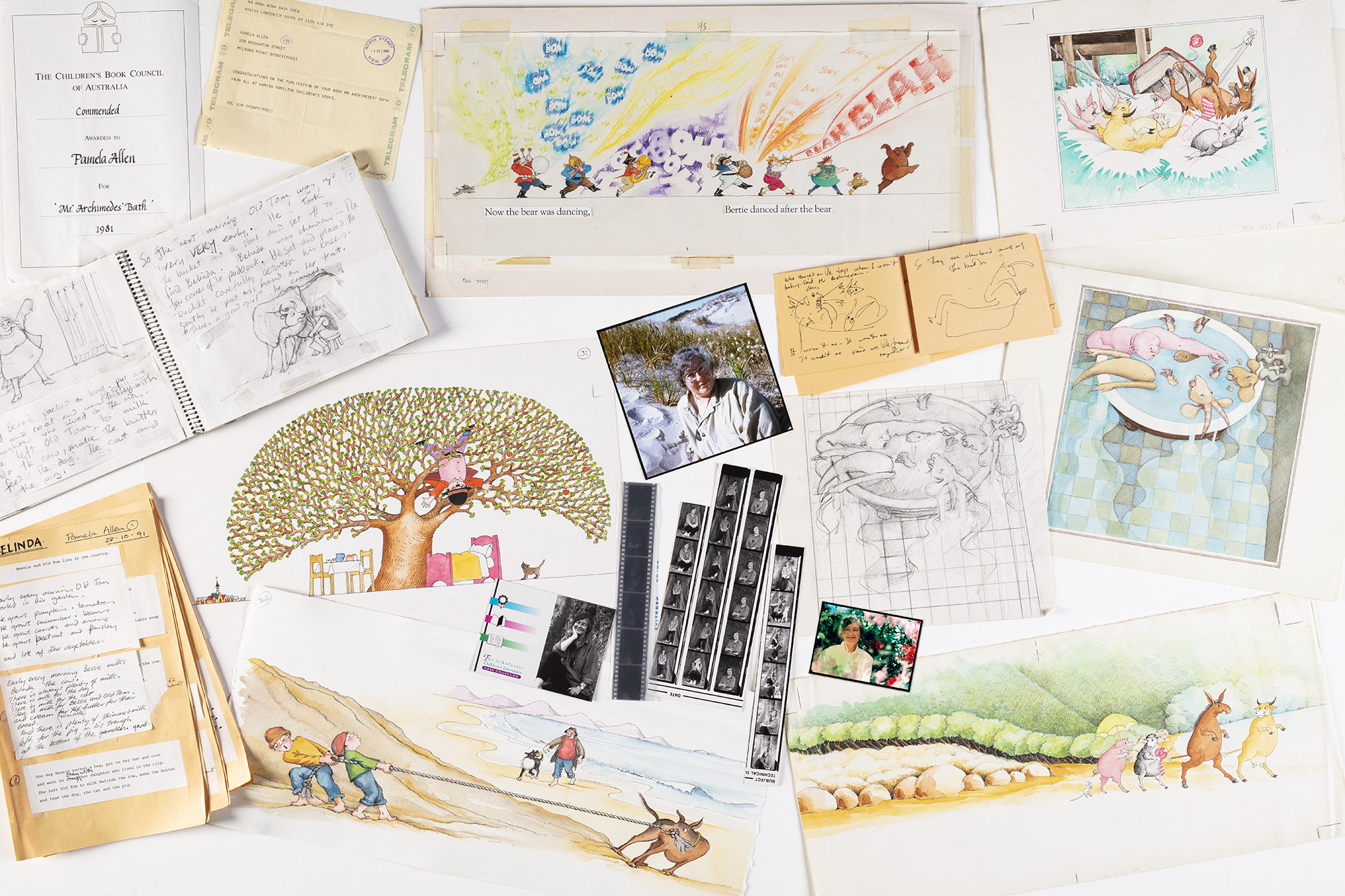The Library is the new home of award-winning children’s author and illustrator Pamela Allen’s extensive archive.
For the past four decades, Pamela Allen’s picture books have captivated generations of Australians, with classic titles including Mr Archimedes’ Bath, Who Sank the Boat?, Mr McGee and Alexander’s Outing securing her place in the national psyche.

Original artwork by Pamela Allen for Alexander’s Outing, 1993
Allen’s literary career began in New Zealand — where she was born in 1934 — after her two children started school. Having been immersed in the playcentre movement when her children were younger, she read hundreds of picture books and developed an understanding of what worked and what didn’t.
She began by illustrating a series of small books written by her friend Jan Farr. The first, Mummy Do Monsters Clean Their Teeth?, was published in 1975 by Heinemann Education. The pair produced four books together between 1975 and 1977, and the basic elements of Allen’s distinctive style can already be seen in her simple illustrations for these titles.
Allen moved to Sydney with her husband and two children in 1978. Eager for work and keen continue her career in children’s book illustration, she began approaching Sydney publishing houses with a portfolio of her work. The seed for her distinguished career was planted during a meeting at the company William Collins with children’s editor Anne Bower Ingram, who suggested Allen write and illustrate her own books.

Original artwork by Pamela Allen for Mr Archimedes’ Bath, 1980
Almost overnight, Pamela Allen became a household name in Australian children’s literature. Her first book, Mr Archimedes’ Bath, published by Collins in 1980, received a NSW Premier’s Literary Award and was commended by the Children’s Book Council of Australia in the category of Picture Book of the Year category in 1981. She then won the Children’s Book Council of Australia’s Picture Book of the Year Award for Who Sank the Boat? (1983) and Bertie and the Bear (1984). She is the first illustrator to have won this award two years running and has been shortlisted for the award six times.

Original artwork by Pamela Allen for Who Sank the Boat?, 1982
Allen’s work has been acknowledged internationally, receiving the Honour Diploma for Illustration from the International Board on Books for Young People for her titles Who Sank the Boat? in 1984 and Grandpa and Thomas in 2006.
Contemporary Australian picture books had their origins in the work of May Gibbs and Dorothy Wall, who dominated the field in the first half of the twentieth century. The 1970s saw a dramatic increase in the publication and popularity of children’s picture books in Australia, and children’s literature authority Maurice Saxby has called the period from 1970 to 1990 the golden age of the Australian picture book. Allen was a major player during those years, writing and illustrating 12 books, including the classics Who Sank the Boat? and Mr McGee.

Original artwork by Pamela Allen for Who Sank the Boat?, 1982
Her 52 books sold more than 6.5 million copies worldwide (excluding translations), and she also illustrated eight books for other authors. Sixteen of her titles have been translated into other languages, including Chinese, Japanese, Maori and Samoan, and many European languages. Thirty-six of her books are still in print today, and Mr Archimedes’ Bath has never been out of print in Australia, the United Kingdom and the United States.
The extensive archive recently acquired by the Library contains more than 460 original illustrations, both published and unpublished, for 56 of Allen’s books and more than 76 boxes of manuscript material. Titles range from Mummy How Cold is a Witch’s Nose? produced with Jan Farr in 1976 to The Big Fish and The Man with the Messy Hair, both published in 2015.
Each set of drawings comes with a box of correspondence, licensing agreements, reviews and other documents relating to the particular book, and in most cases one or more ‘dummy books’. Dummy books are an important part of Allen’s creative process in producing her 32-page picture books. These collages of original pencil and photocopied drawings, with various iterations of Allen’s words, record the evolution of each title.

A pencil study for an original artwork by Pamela Allen for Mr Archimedes’ Bath, 1980
The archive also includes Allen’s correspondence with her editors, publishers and literary agents, providing a window into the Australian book publishing industry over the past 40 years. It’s incredibly rare in the world of children’s picture books that an archive as complete as this one is kept intact.

Selection of material from Pamela Allen archive
Allen describes the process of producing a picture book as a personal journey. She writes for the young, particularly pre-readers and early readers, and her simple text is rich with repetition and musicality, perfect for reading aloud. Her words provide the reader with an opportunity to animate and personalise the story through theatrical performance. For Allen, the illustrations and words are symbiotic, working together to create meaning. Textual repetition is a deliberate feature of Allen’s books, enhancing word recognition and understanding for her young audience.
Her stories explore universal themes, drawing ideas from life experience and teaching valuable lessons about lateral thinking and conflict resolution. Some, such as Belinda and Our Daft Dog Danny, are narrative in style; others are repetitious and onomatopoeic, using rhythm and rhyme to reinforce the action that is implicit in her illustrations — Bertie and the Bear and Clippity Clop are great examples. While some of Allen’s books are whimsical, others feature more serious themes such as greed (Herbert and Harry), gluttony (Brown Bread and Honey) and feelings of abandonment (Black Dog).

Original artwork by Pamela Allen for Mr McGee, 1987
Allen’s pen, ink and watercolour drawings are often set on a clean white page, giving emphasis to the detailed image. The Pamela Allen archive takes its place at the Library alongside the work of many other significant authors and illustrators published in the late twentieth and early twenty-first century including Dick Roughsey, Percy Tresize, Desmond Digby, Julie Vivas, Libby Hathorn, Alison Lester, Bronwyn Bancroft and Jeannie Baker, as well as the archival material of May Gibbs, Norman Lindsay, Ida Rentoul Outhwaite, Dorothy Wall and other classic figures in Australian children’s literature. It records the successful professional career of one of Australia’s best-loved children’s author/illustrators.
Sarah Morley, Curator, Research & Discovery


